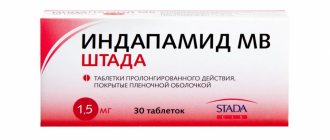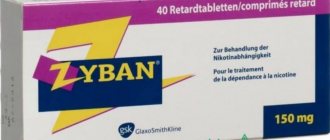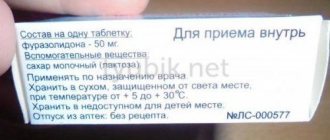pharmachologic effect
Antiepileptic drug.
Diphenine exhibits an anticonvulsant effect without a pronounced hypnotic effect. The mechanism of the anticonvulsant action of Diphenin has not been fully established. It is believed that the specific effect of Diphenin is realized in epilepsy by reducing the excitability of neurons in the epileptic focus and influencing neurotransmitters. The drug blocks sodium channels, prolongs their inactivation time, and prevents the generation and propagation of high-frequency discharges. The drug also exhibits an antiarrhythmic effect. The antiarrhythmic effects of Diphenin may be due to the normalization of the entry of sodium and calcium ions into the cells of the cardiac Purkinje fibers. The drug inhibits abnormal automaticity and duration of action potentials in the His-Purkinje system by reducing repolarization time and shortens the effective refractory period.
special instructions
During treatment, careful selection of doses is necessary (for epilepsy, the concentration in the blood is determined on the 7-10th day of treatment), since an increase in dose may be accompanied by a disproportionate increase in plasma levels.
During the treatment period, it is necessary to monitor the content of Ca2+ and phosphorus in the blood serum. In case of severe side effects, the dose of the drug is reduced or treatment is stopped. Patients with impaired liver function and the elderly require adjustment of the dosage regimen.
In acute alcohol intoxication, the concentration of Diphenin increases, and in chronic alcohol intoxication, it decreases.
During the treatment period, it is necessary to refrain from driving vehicles and engaging in potentially dangerous activities, activities that require increased concentration and speed of psychomotor reactions.
Substance-powder Diphenine
Instructions for medical use of the drug
Description of pharmacological action
Anticonvulsant, hydantoin derivative. It has anticonvulsant, antiarrhythmic, analgesic, and muscle relaxant effects. It is believed that the anticonvulsant effect is due to the stabilization of the membranes of neurons, axons and synapses, as well as limiting the spread of excitation and seizure activity. Like other hydantoin anticonvulsants, phenytoin has an excitatory effect on the cerebellum, activating inhibitory pathways that extend to the cerebral cortex. This effect may also lead to a decrease in seizure activity, which is associated with increased discharges in the cerebellum. The antiarrhythmic effect is due to the membrane-stabilizing activity of phenytoin in Purkinje fiber cells. Blocks transmembrane sodium current, reduces the permeability of the cell membrane to calcium ions. Abnormal ventricular automaticity and membrane excitability are reduced. Phenytoin also shortens the refractory period and widens the QRS complex. Increases the pain threshold for trigeminal neuralgia and shortens the duration of the attack, reducing excitation and the formation of repeated discharges. The mechanism of muscle relaxant action is apparently similar to the mechanism of anticonvulsant action. Due to its membrane-stabilizing activity, in case of motor disorders, it weakens prolonged repeated discharges and potentiation in nerve and muscle cells. Hydantoin derivatives induce microsomal liver enzymes, thereby enhancing the metabolism of simultaneously used drugs.
Indications for use
Epilepsy (grand mal seizures); status epilepticus with tonic-clonic seizures; epileptic seizures in neurosurgery (prevention and treatment). Ventricular arrhythmias (including with glycoside intoxication or associated with intoxication with tricyclic antidepressants). Trigeminal neuralgia (as a second-line agent or in combination with carbamazepine).
Release form
powder substance; double-layer polyethylene bag (bag) 1 kg, paper bag (bag) 1; powder substance; double-layer polyethylene bag (bag) 5 kg, paper bag (bag) 1; powder substance; double-layer polyethylene bag (bag) 10 kg, paper bag (bag) 1; powder substance; double-layer polyethylene bag (bag) 15 kg, paper bag (bag) 1;
Pharmacodynamics
Anticonvulsant, hydantoin derivative. It has anticonvulsant, antiarrhythmic, analgesic, and muscle relaxant effects. It is believed that the anticonvulsant effect is due to the stabilization of the membranes of neurons, axons and synapses, as well as limiting the spread of excitation and seizure activity. Like other hydantoin anticonvulsants, phenytoin has an excitatory effect on the cerebellum, activating inhibitory pathways that extend to the cerebral cortex. This effect may also lead to a decrease in seizure activity, which is associated with increased discharges in the cerebellum. The antiarrhythmic effect is due to the membrane-stabilizing activity of phenytoin in Purkinje fiber cells. Blocks transmembrane sodium current, reduces the permeability of the cell membrane to calcium ions. Abnormal ventricular automaticity and membrane excitability are reduced. Phenytoin also shortens the refractory period and widens the QRS complex. Increases the pain threshold for trigeminal neuralgia and shortens the duration of the attack, reducing excitation and the formation of repeated discharges. The mechanism of muscle relaxant action is apparently similar to the mechanism of anticonvulsant action. Due to its membrane-stabilizing activity, in case of motor disorders, it weakens prolonged repeated discharges and potentiation in nerve and muscle cells. Hydantoin derivatives induce microsomal liver enzymes, thereby enhancing the metabolism of simultaneously used drugs.
Pharmacokinetics
When taken orally, absorption is slow and varies depending on the dosage form used. With intramuscular administration, absorption is also slow, but almost complete - 92%. Phenytoin penetrates into the cerebrospinal fluid, saliva, semen, gastric and intestinal juice, bile, and is excreted in breast milk. Penetrates through the placental barrier, concentrations in maternal blood plasma are equal to concentrations in fetal plasma. Protein binding 90% or more. Metabolized in the liver with the participation of isoenzymes CYP2C9, CYP2C19 with the formation of inactive metabolites. It has been established that a constant amount of the active substance is metabolized due to the saturation of the enzyme system responsible for the metabolism of phenytoin, which occurs when therapeutic concentrations are reached. Therefore, a small increase in dose may lead to a disproportionately significant increase in plasma concentrations of the active substance and T1/2. Phenytoin is an inducer of the isoenzymes CYP1A2, CYP3A4. T1/2 depends on the dose, the concentration of the active substance in plasma. It is excreted by the kidneys in the form of metabolites and through the intestines.
Use during pregnancy
Phenytoin should not be used during pregnancy unless the benefit to the mother outweighs the risk to the fetus. There is anecdotal evidence of tumor formation (including neuroblastoma), cleft lip and palate in children whose mothers received phenytoin during pregnancy. Phenytoin is excreted into breast milk in concentrations sufficient to cause side effects in a nursing infant. In this regard, the use of phenytoin during lactation is not recommended.
Contraindications for use
Morgagni-Adams-Stokes syndrome, AV block II and III degrees, sinoatrial block, sinus bradycardia, liver and kidney dysfunction, heart failure, cachexia, porphyria, hypersensitivity to phenytoin.
Side effects
From the central nervous system and peripheral nervous system: possible - nystagmus, ataxia, confusion, mood changes, muscle weakness, impaired coordination of movements, dizziness, sleep disturbances, slurred speech or stuttering, hand tremors, transient nervousness; rarely - peripheral neuropathy. From the digestive system: possible - nausea, vomiting, constipation, toxic hepatitis, liver damage. Gingival hyperplasia can occur during the first 6 months of therapy and begins with gingivitis, most often observed in patients under the age of 23 years. From the hematopoietic system: rarely - thrombocytopenia, leukopenia, granulocytopenia, agranulocytosis, pancytopenia, megaloblastic anemia. From the endocrine system: possible - hypertrichosis, enlargement of facial features, including thickening of the lips, widening of the tip of the nose and protrusion of the lower jaw. From the metabolic side: possible - impaired absorption of glucose due to inhibition of insulin release, impaired metabolism of vitamin D and the development of hypocalcemia. From the musculoskeletal system: possible - Dupuytren's contracture; rarely - peripheral polyarthropathy. With prolonged use, the absence of an adequate diet that satisfies the need for vitamin D, or sufficient solar radiation during the treatment period, osteomalacia and rickets may develop. Allergic reactions: rarely - skin rash, which may be a prodromal sign of more severe skin reactions (Stevens-Johnson syndrome, toxic epidermal necrolysis), eosinophilia, fever, drug-induced lymphadenopathy. Other: rarely - Peyronie's disease.
Directions for use and doses
For oral administration in adults, the initial dose is 3-4 mg/kg/day, followed by increasing the dose until the optimal therapeutic effect is achieved. In most cases, the maintenance dose is 200-500 mg/day in one or more doses. Children - 5 mg/kg/ in two doses, followed by increasing the dose to no more than 300 mg/ Maintenance doses - 4-8 mg/kg/ For intravenous administration to adults and children, the initial dose is 15-20 mg/kg. Depending on the clinical situation, a single dose may be 50-100 mg/kg. For newborns, the initial dose is also 15-20 mg/kg. Adults can be administered intramuscularly in a single dose of 100-300 mg.
Interactions with other drugs
When used simultaneously with drugs that have a depressant effect on the central nervous system, the depressant effect on the central nervous system may be enhanced. With the simultaneous use of amiodarone, antifungals (including amphotericin B, fluconazole, ketoconazole, miconazole, itraconazole), metronidazole, chloramphenicol, chlordiazepoxide, diazepam, dicumarol, histamine H1 receptor blockers, halothane, isoniazid, methylphenidate, omeprazole, fluoxet ina , estrogens, salicylates, succinimides, sulfinpyrazone, sulfonamides, tolbutamide, trazodone, it is possible to increase the concentration of phenytoin in the blood plasma, which leads to an increase in its therapeutic effect and increases the risk of side effects. The therapeutic effect of antifungals, clozapine, GCS, dicumarol, digitoxin, doxycycline, furosemide, estrogens, oral contraceptives, quinidine, rifampicin, vitamin D changes with the simultaneous use of phenytoin. When used simultaneously with phenothiazine derivatives (including chlorpromazine, prochlorperazine, thioridazine), phenobarbital, and antitumor agents, an increase or decrease in the concentration of phenytoin in the blood plasma is possible. The effect of phenytoin on plasma concentrations of phenobarbital is unpredictable. When used simultaneously with acetazolamide, osteomalacia and rickets are possible. When used simultaneously with acyclovir, it is possible to reduce the concentration of phenytoin in the blood plasma and reduce its effectiveness. With simultaneous use of valproic acid during the first few weeks, the total concentration of phenytoin in the blood plasma may decrease due to its displacement from sites of binding to plasma proteins by sodium valproate, induction of microsomal liver enzymes and acceleration of phenytoin metabolism. Next, the metabolism of phenytoin is inhibited by valproate and, as a result, the concentration of phenytoin in the blood plasma increases. Phenytoin reduces plasma concentrations of valproate, probably by increasing its metabolism in the liver. It is believed that phenytoin, as an inducer of liver enzymes, also increases the formation of a minor but hepatotoxic metabolite of valproic acid. With simultaneous use, the plasma concentrations of verapamil, nimodipine, and felodipine decrease. A case has been described of an increase in the concentration of phenytoin in the blood plasma and the development of toxic effects when used simultaneously with gabapentin. With simultaneous use, a decrease in the concentration of desipramine in the blood plasma is possible. When used simultaneously with diltiazem and nifedipine, it is possible to increase the concentration of phenytoin in the blood plasma and create a risk of developing toxic effects. When used simultaneously with disulfiram, it is possible to increase the concentration of phenytoin in the blood plasma with the development of toxic reactions; with imipramine, clarithromycin - it is possible to increase the concentration of phenytoin in the blood plasma. When used simultaneously with carbamazepine, folic acid, reserpine, sucralfate, vigabatrin, the concentration of phenytoin in the blood plasma may decrease and its therapeutic effect may decrease. In patients receiving phenytoin, the effectiveness of paracetamol may be reduced. When taking pyridoxine at a dose of 200 mg/day, a decrease in the concentration of phenytoin in the blood plasma is possible. When used simultaneously with ritonavir, there are reports of increased plasma concentrations of phenytoin. It is believed that interaction is possible, but its nature has not been definitively established. When used simultaneously with sucralfate, the absorption of phenytoin is reduced. When used simultaneously with theophylline, it is possible to reduce the plasma concentrations of phenytoin and theophylline and reduce their effectiveness. When used simultaneously with felbamate, it is possible to increase the concentration of phenytoin in the blood plasma. When used simultaneously with phenylbutazone, cases of increased concentrations of phenytoin in the blood plasma with the development of toxic reactions have been described. When treating folic acid deficiency, the use of folic acid preparations reduces the effectiveness of phenytoin. When used simultaneously with cimetidine, the concentration of phenytoin in the blood plasma increases, and there is a risk of developing toxic effects. When used simultaneously with ciprofloxacin, a decrease or increase in the concentration of phenytoin in the blood plasma is possible. The interaction is ambiguous.
Special instructions for use
If you are hypersensitive to one of the hydantoin anticonvulsants, hypersensitivity to other drugs in this group is also possible. Sudden cessation of phenytoin treatment in patients suffering from epilepsy may trigger the development of withdrawal syndrome. In patients with epilepsy, if abrupt discontinuation of phenytoin is necessary (for example, in the event of allergic or hypersensitivity reactions), anticonvulsants other than hydantoin derivatives should be used. Phenytoin undergoes intensive metabolism in the liver, so patients with impaired liver function, as well as the elderly, require dosage adjustment. During treatment, especially long-term treatment, a diet that satisfies the need for vitamin D and exposure to UV radiation is recommended. When using the drug in children during the growth period, the risk of developing side effects from connective tissue increases. In acute alcohol intoxication, the concentration of phenytoin in plasma may increase, and in chronic alcoholism, it may decrease. Effect on the ability to drive vehicles and operate machinery. During the treatment period, a slowdown in the speed of psychomotor reactions is observed. This must be taken into account by persons engaged in potentially hazardous activities that require increased attention and speed of psychomotor reactions.
Storage conditions
List B: In a dry place, protected from light, at a temperature not exceeding 25 °C.
Best before date
60 months
ATX classification:
N Nervous system
N03 Antiepileptic drugs
N03A Antiepileptic drugs
N03AB Hydantoin derivatives
N03AB02 Phenytoin



